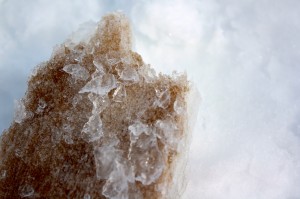Lamont-Doherty Earth Observatory151
-

A Tale of Sea Ice, Algae and the Arctic
I returned to New York on Monday, but Lamont-Doherty Earth Observatory scientists Andy Juhl and Craig Aumack remain working in Barrow, Alaska for another week. They’ll continue to collect data and samples in a race against deteriorating Arctic sea ice conditions as the onset of summer causes the ice to thin and break up.
-
Arctic Current Flowed Under Deep Freeze of Last Ice Age, Study Says
Evidence Retrieved from Sediments in Remote Polar Basins
-

Science, Creativity and Isopods
It’s near midnight and Lamont-Doherty Earth Observatory researchers Andy Juhl and Craig Aumack, and Arizona State’s Kyle Kinzler are gathered around a table in their lab at the Barrow Arctic Research Consortium discussing the best way to catch an isopod.
-

Ctene Sensations of the Arctic Ocean
One of the goals of Andy Juhl’s and Craig Aumack’s Arctic research is to determine the role of ice algae as a source of nutrition for food webs existing in the water column and at the bottom of the Arctic ocean.
-

Collecting Core Data About Arctic Ecosystems
Our team spent most of Friday on the Arctic sea ice, drilling and sampling ice cores at our main field site. For each core collected, Lamont-Doherty Earth Observatory scientists Andy Juhl and Craig Aumack take a number of different physical, chemical and biological measurements
-

What Lies Beneath Arctic Ice?
On Thursday we lowered a camera into an ice borehole to get a look at the underside of the ice. In the following video, you can clearly see the algae living in the bottom of the ice due to their pigments, which they use to harvest light.
-

Ice Capades
Fieldwork is exciting and inspiring, leading scientists to new ideas, places and observations about how the world works. Spring on Alaska’s North Slope provides an especially productive environment for fieldwork. When the sun never sets, it’s easy to linger in the field and the lab long into the well-lit night.
-

Settling in to Work and Life in Barrow
While I arrived in Barrow, Alaska on Tuesday, Lamont-Doherty Earth Observatory scientists Andy Juhl and Craig Aumack, and graduate student Kyle Kinzler from Arizona State University, got here one week ago.
-

Investigating Life in Arctic Sea Ice
Andy Juhl and Craig Aumack, microbiologists from Columbia University’s Lamont-Doherty Earth Observatory, are spending a month in Barrow, Alaska studying algae in and below sea ice, and how our warming climate may impact these important organisms.

AGU25, the premier Earth and space science conference, takes place December 15-19, 2025 in New Orleans, Louisiana. This year’s theme—Where Science Connects Us—puts in focus how science depends on connection, from the lab to the field to the ballot box. Once again, Lamont-Doherty Earth Observatory and Columbia Climate School scientists, experts, students, and educators are playing an active role, sharing our research and helping shape the future of our planet. #AGU25 Learn More
